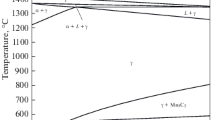The work is part of fundamental research for alloys of the Fe–Mn system. Alloys are prepared for the first time of optimum composition with the maximum possible amount of ε-martensite (65–95%), and their mechanical properties are determined in relation to the crystal lattice type (BCC, FCC, HCP), manganese content, and preparation method.
Similar content being viewed by others
References
A. P. Gulyaev, Materials Science [in Russian], Metallurgiya, Moscow (1977).
I. N. Bogachev and V. F. Egolaev, Structure and Properties of Iron-Manganese Alloys [in Russian], Metallurgiya, Moscow (1973).
T. F. Volunova, High-Manganese Steels and Alloys [in Russian], Metallurgiya, Moscow (1988).
A. P. Gulyaev, I. Ya. Georgieva, and T. F. Volynova, “Phase transformation in alloys of the Fe–Mn system of high purity,” MiTOM, No. 3, 2–6 (1978).
O. G. Sokolov and K. B. Katsov, Iron-Manganese Alloys [in Russian], Naukova Dumka, Kiev (1982).
Yu. N. Makagon and V. I Nikolin, “Effect of repeated martensitic transformation on the mechanical properties of steel G20 and steel 35G18,” FMM, 29, No. 5, 674–678 (1970).
I. M. Bogachev, G. E. Zvigintseva, and V. F. Egolaev, “Effect of alloying elements on magnetic transformation ironmanganese alloy,” FMM, 28, No. 4, 1018–1024 (1969).
H. Schumann, “Die martensitischen Umwandlungen in kohlenstoffarmen Manganstahlen,” Archiv für das Eisenhüttenwesen, 38, No. 8, 721–730 (1967).
A. Holden and I. Bolton, “The structure of iron-manganese alloys,” J. Iron and Steel Inst., 209, 721–730 (1971).
Yu. G. Virakhovskii,Ya. B. Gurevich, and M. O. Nogaev, “Use of martensitic transformation caused by deformation for increasing the ductility of austenitic steels strengthened by hot working,” FMM, 32, No. 2, 348–363 (1971).
B. A. Potekhin, “Contribution of martensitic transformation during deformation on the ductility of metastable austenitic steels,” FMM, 40, No. 3, 856–860 (1979).
Yu. G. Dorofeev and N. T. Zherditskii, “Effect of composition on the structure and properties of steel G13M,” Trudy NPI, No. 6, Novocherkassk (1979), pp. 146–152.
A. Shalak, “Effect of a fine-grained structure of powder iron on improvement of the properties of sintered steels alloyed with manganese,” FMM, 41, No. 1, 100–105 (1980).
N. G. Davydov and B. M. Blagikh, Increase in the Quality of Steel 110G13A Castings (Tomsk, 1972) [in Russian], Metallurgiya, Moscow (1972), pp. 114–116.
Author information
Authors and Affiliations
Corresponding author
Additional information
Translated from Metallurg, No. 9, pp. 56–60, September, 2009.
Rights and permissions
About this article
Cite this article
Volynova, T.F., Buravlev, I.K. & Lushkin, M.A. Mechanical properties of antifriction iron-manganese alloys on a metastable base. Metallurgist 53, 565–571 (2009). https://doi.org/10.1007/s11015-010-9215-3
Received:
Published:
Issue Date:
DOI: https://doi.org/10.1007/s11015-010-9215-3




